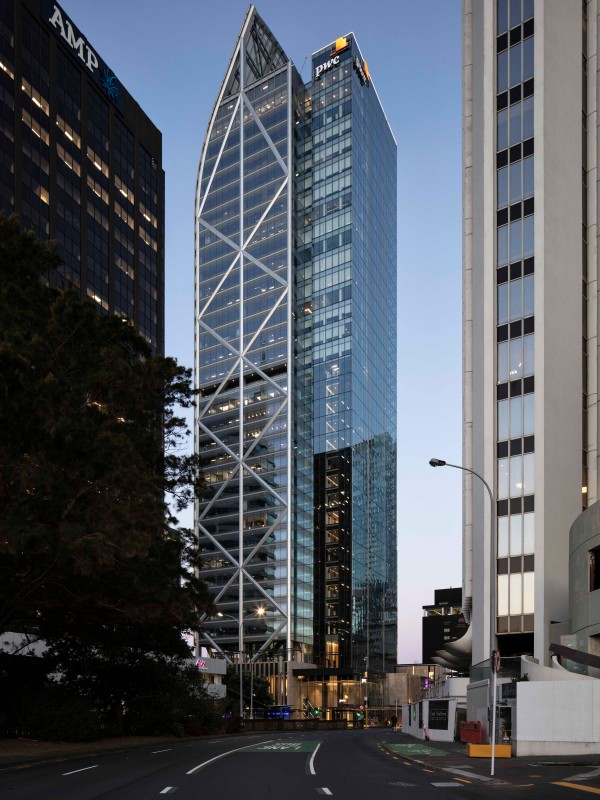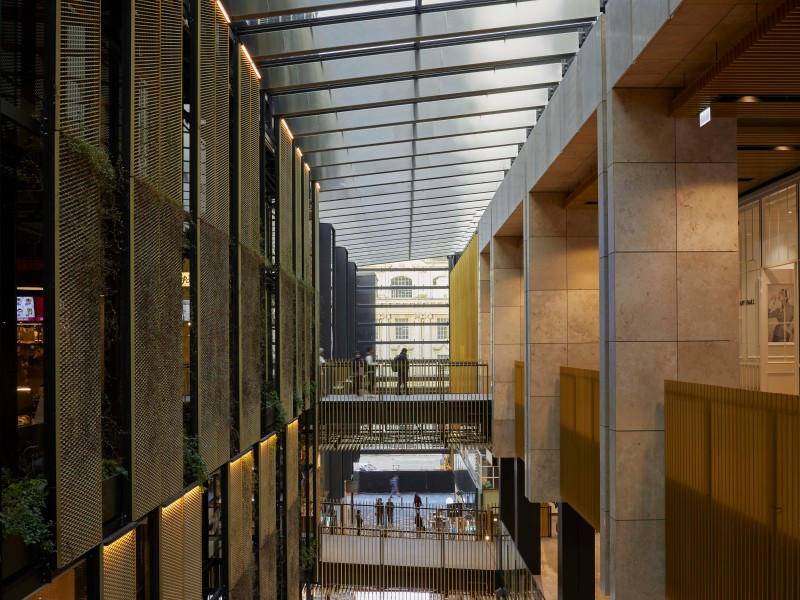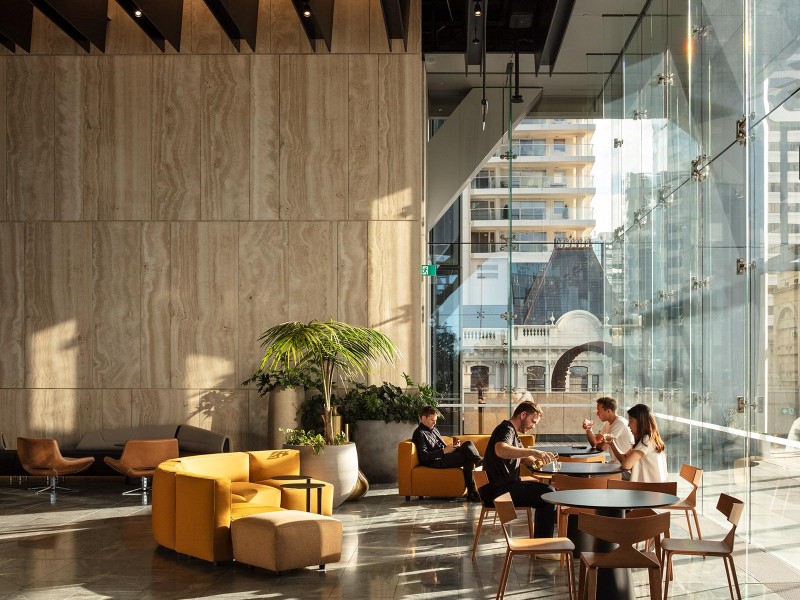The country’s tallest commercial structure - the dynamic 5 Green Star rated PwC Tower – has transformed Auckland’s skyline.
And its owner is transforming the future of our built environment with its trailblazing pledge to the World Building Council Net Zero Carbon Buildings Commitment.
The first property owner in Aotearoa to sign up to the global agreement, Precinct Properties has committed to achieving net zero carbon emissions for all buildings in its operational control by 2030 and to maximise reductions of embodied carbon emissions at new developments and major upgrades of existing assets.
PwC Tower now stands as a striking example of that commitment, and how major developments can help champion more sustainable, efficient design and construction.

Essentials
Name: PwC Tower at Commercial Bay
What: a 39-storey commercial tower, including a multi-level retail centre with high-end shopping, restaurants, bars and eateries and 3 levels of basement carparking
Where: the PwC Tower sits centre stage within the waterfront Commercial Bay precinct and is interconnected to four adjacent office towers. It’s built opposite Britomart train station and above two new tunnels serving the City Rail Link.
Address: 15 Customs Street West, Tāmaki Makaurau Auckland
Commercial tenancy: 19 commercial tenants including pre-committed anchor tenants PwC, Chapman Tripp, Minter Ellison, Jarden and DLA Piper whose building performance specifications required a 5 Green Star certification and minimum 4 star NABERSNZ rating for the building
Retail centre tenancy: over 100 operators
Daily occupancy of commercial floors: over 2000 people
Daily visitors to retail centre: 20,000 to 25,000 people
Project Snapshot
Owner: Precinct Properties NZ Ltd - the largest owner and developer of premium inner-city real estate in Auckland and Wellington
Architect: Warren and Mahoney in association with Woods Bagot and NH Architecture
Main contractor: Fletcher Construction
GSAP: Peter Bryant, SEEC Ltd
Project timeline: 2013; master-plan commenced, 2016; construction commenced, June 2020; retail centre opens, July 2020; PwC Tower is occupied
Project certification:
5 Green Star Office Built (July 2022)
5 Green Star Office Design (November 2018)

Holding prominence above the CBD’s bustling Commercial Bay, the state-of-the-art PwC Tower is helping lead the revitalisation of commercial, retail and hospitality in downtown Auckland.
Embedded with green technology, energy-smart infrastructure and a new generation ‘side core’ floorplate, the building offers dramatic views over the city and Waitematā, and a spectacular arrival experience in city-side glazed lifts.
Precinct says the green wish-list of its anchor tenants, combined with its own aspirations, fuelled the project’s initial 5 Green Star target.
Thanks to constant focus from the very first sustainable design conversations through to successful sustainable practices onsite have now delivered the building’s ‘New Zealand excellence’ result.
“We feel incredibly proud to have achieved 5 stars and it’s something the project team considered in each decision made. Our internal operations team was incredibly driven by our target including the Fletcher’s design and construction team, its consultancy team, our internal team and our clients,” says Precinct CFO and sustainability lead, Richard Hilder.
“We think our 5 Green Star rating makes the PwC Tower a more desirable place to work and the fact that it’s 100% leased reflects this. More people want to work in high-rated Green Star buildings with the amenities they provide. There’s also an expectation to deliver this high standard of building from our clients when engaging in leasing discussions.”
Richard says one of the benefits of using Green Star is it identifies areas of sustainable management and reporting.
“It outlines a universal understanding for several different stakeholders as well as being recognised by clients and the industry. This then provides a benchmark for consultants to design to.”
Precinct has become a leading voice in the sustainable building space, with 10 Green Star rated properties (over 50 percent of its portfolio) and three further Green Star registered projects in the pipeline.
He says his best piece of advice for those embarking on a Green Star project is to have clear-cut objectives and an enthusiastic project team.
“Establish your sustainability strategy and objectives early and establish a passionate team - internal and external - to deliver on these things.”
- Precinct CFO and sustainability lead, Richard Hilder.'

That passion to design and deliver the PwC Tower has been a seven year focus for architects Warren and Mahoney.
Principal, Michael Mason, says Warren and Mahoney was focused on low energy outcomes for the project but also wanted to provide clarity – the ability to see into the building.
“When you look at the Auckland skyline in the majority of light conditions most tall buildings appear monolithic – as if they could be sculpted from a single block of material. We wanted something with depth that appeared to be constructed of its parts – floorplates, ceilings, a structural frame, lifts and a skin. There’s a natural tension though between maximizing views out, providing clarity to the façade and the energy profile of the building.”
He says delivering on these competing design drivers required a sophisticated facade solution.
“After significant research we settled on ceramic frit to improve the performance of the base glass to achieve the shading co-efficient to the point needed by the mechanical system. We worked with a German supplier who was one of only two glass manufacturers in the world at the time who could apply a low-E coating over the frit.”
Michael says along with its façade another key sustainability strategy of the PwC Tower has been a focus on promoting active transport.
“End of trip facilities are provisioned above Green Star requirements in terms of quantity and are commensurate with tenancy ‘on floor’ amenities in terms of quality. We really wanted to reward and incentivise the active-commuters with a great experience”.
While city-shaping projects like the PwC Tower are inherently complex Michael says the building’s scale and location presented an opportunity to create a better urban environment, to extend Auckland’s laneway network, and repair that area of the city.
“We knew these outcomes far outweighed the challenges involved - which drove a best-for-project-approach throughout.”
He says Green Star contributed significantly to this ethos and delivered attention to detail during the seven year project.
“A rating system like Green Star focuses minds and provides measurable targets. It takes away the guess work about where you’re going to land in a sustainability context and does it in a way that is communicable to stakeholders.”
-Warren and Mahoney Principal, Michael Mason.
Project GSAP and SEEC Ltd director, Peter Bryant, says given the size and complexity of the project, PwC Tower’s 5 Star rating is a great achievement.
“The Green Star rating was a central focus of this large-scale, high-profile project - and despite the challenges that came with the pandemic, a busy waterfront location and a large stakeholder base, the project team remained fully committed to achieve this excellent result,” Peter says.
That busy, high-profile location necessitated detailed planning and co-ordination for main contractor Fletcher Construction around the interface requirements with the surrounding City Rail Link works and streetscape activity.
“The PwC Tower project was directly linked to the rail tunnels for the City Rail Link (CRL) expanded network. We actually constructed part of the tunnel network under the PwC Tower. The physical separation strategies in our design and verification requirements to avoid vibration transfer were a complication. We also had to jointly plan and programme our works so that neither CRL or Fletchers affected each other’s schedule,” says Fletcher Construction executive general manager-buildings, John Salier.
He says during the peak of the project Fletcher Construction had 2,200 people on site with Precinct engaging an extra 500 workers to complete the retail centre fit-out.
Builders and subcontractors attended regular team talks about green site practices.
John says Fletcher Construction’s first goal was not to bring waste to the project.
“Packaging and protection causes such a lot of surplus. Our materials came to site with minimal protection where applicable. We also provided bins for particular products for recycling purposes and separated our waste on site. Materials were also pre-cut or brought to site sized to avoid wastage,” says John.
“Green Star certification is becoming more top of mind for people and this project has raised awareness about efficient energy-saving design. Some subcontractors who worked on the PwC Tower have adopted the outputs of the project to showcase their contribution and are now using the Green Star rating as a marketing tool.”
- Fletcher Construction executive general manager-buildings, John Salier.

Anchor tenant PwC says there is so much to love about working in the building.
“Our vision at PwC is to create vibrant, open, agile, innovative, collaborative and tech-enabled workplaces for our people and clients and PwC Tower exemplifies this. More than 900 people are able to work from our offices in a variety of settings from quiet work zones, dedicated individual workspaces through to interactive collaboration spaces and our flexible co-creation experience centres. The breath-taking views and abundance of natural light as well as the impressive end-of-trip facilities create an incredible working environment for our people,” says PwC CEO and senior partner, Mark Averill.
He says the PwC Tower has exceeded the company’s expectations.
“As part of our sustainability commitments PwC has set clear targets to reduce our environmental impact to become net carbon zero by 2030 and drive efficiencies to achieve positive environmental outcomes. This includes reducing our carbon impact as a business and using 100% renewable energy in all our offices throughout Aotearoa New Zealand,” says Mark.
“ Precinct has been very supportive in facilitating some of our sustainability initiatives such as installing PwC beehives in the complex and assisting with our waste reduction project. It is exciting to see Precinct’s commitment to making the PwC Tower net zero and how we can work in tandem.”'
Green features include:
|
Technical features include:
Innovation points awarded to the project include:
|
